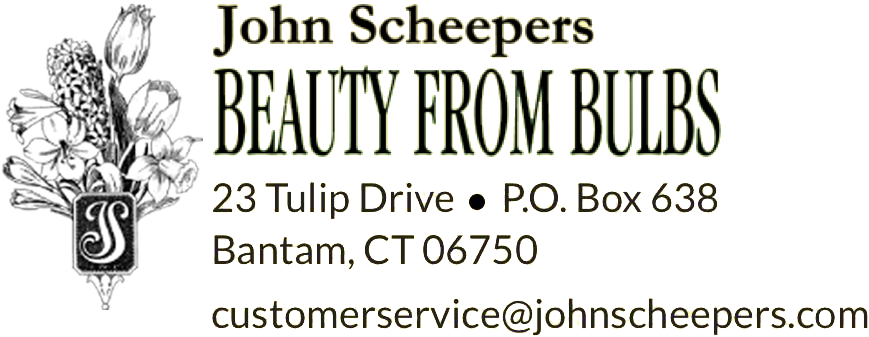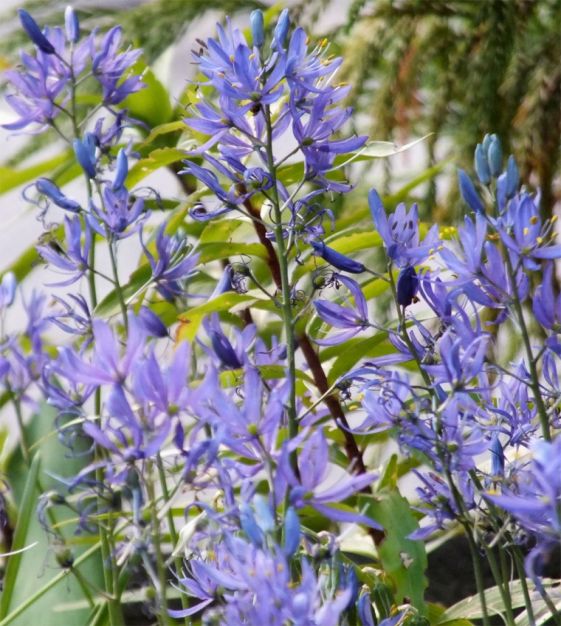-
- 20%-Off Website Specials
- New for 2024!
- Tulips
- Narcissi
- Allium
- Anemone blanda
- Brodiaea
- Camassia
- Chionodoxa
- Corydalis
- Crocus
- Eranthis
- Eremurus
- Erythronium
- Fritillaria
- Galanthus
- Geranium
- Gladiolus
- Hyacinths
- Hyacinthoides
- Ipheion uniflorum
- Dutch Iris
- Rock Garden Iris
- Ixiolirion
- Leucojum Aestivum
- Muscari
- Ornithogalum
- Oxalis
- Puschkinia
- Scilla
- Lilies
- Peonies
- Tender Bulbs
- Anemone Giants
- Tecolote Ranunculus
- Freesias
- Paperwhites
- Amaryllis
Camassia quamash Orion
This 1913 hybrid is best grown in moist, fertile soil in full sun to partial sunlight. Unlike most bulbs, it prefers soil that has a bit more moisture. Deer- and rodent-resistant, C. quamash Orion forms ever substantive clusters of linear strappy foliage around upright racemes studded with dozens of six-petaled, 2", star-shaped deep violet-blue flowers with yellow anthers and whisper-green centers. The flowers open sequentially from the bottom to the top. Bulb size: 6 cm/up. Full to partial sunlight. Bloom time in horticultural zone 5: May/June. HZ: 4-8. Height: 15".
Camassias are The Art & Soul of Spring.
Camassia Horticultural Tips
Camassias are The Art & Soul of Spring.
Camassia Horticultural Tips
- Information
Camassia
A valuable Pacific Northwest U.S. native that’s been cultivated commercially in the Netherlands for a long time, Camassia is best grown in moist, fertile soil in full sun to partial sunlight. Unlike most bulbs, Camassia prefers soil that has a bit more moisture. This stands to reason since it enjoyed soil with good moisture retention in the plains, slopes and foothills west of the Cascade Mountains. Deer- and rodent-resistant, Camassia forms ever-more-substantive clusters of linear strappy foliage from which emerge upright racemes studded with dozens of six-petaled, 2", star-shaped flowers, opening sequentially from the bottom to the top. Depending on the variety, the flowers are white, ivory, blue or purple, most with pretty yellow anthers. Commonly known as The Wild Hyacinth, Camass, Quamash or Leichtlin’s Camass, it’s an incredibly valuable genus since it naturalizes well when left undisturbed in a good spot, and since it blooms in the blank period between the big Narcissus and Tulip spring show and the big summer show when perennials and annuals hit their colorful strides. As it matures over time, when it’s happy where it’s planted, it naturalizes by bulb offsets (called bulbils: baby bulbs on the sides of the mother bulb you’ve planted). As if that weren’t enough, it’s also a good cut flower. Back around 1800, history reports that Sacajawea cooked Camassia bulbs to feed the Lewis and Clark expedition. We do not recommend this: a friend of ours tried this in Holland and found the pasty mush rather repulsive. (Plus, bulbs in the wild can be mistaken as Camassia when in fact, they are a poisonous look-alike.)
You’ll need four bulbs per square foot. (Square footage is determined by multiplying the planting site’s length times its width.) Full to partial sunlight. Bloom time in horticultural zone 5: May/June. Plant 5" deep and 5" apart. If Camassia is planted near a stream or pond, make sure to plant it above the high water mark. Even though Camassia likes soil with a bit of moisture, it can not be submerged in water.
Camassias are The Art & Soul of Spring.
Camassia Horticultural Tips
A valuable Pacific Northwest U.S. native that’s been cultivated commercially in the Netherlands for a long time, Camassia is best grown in moist, fertile soil in full sun to partial sunlight. Unlike most bulbs, Camassia prefers soil that has a bit more moisture. This stands to reason since it enjoyed soil with good moisture retention in the plains, slopes and foothills west of the Cascade Mountains. Deer- and rodent-resistant, Camassia forms ever-more-substantive clusters of linear strappy foliage from which emerge upright racemes studded with dozens of six-petaled, 2", star-shaped flowers, opening sequentially from the bottom to the top. Depending on the variety, the flowers are white, ivory, blue or purple, most with pretty yellow anthers. Commonly known as The Wild Hyacinth, Camass, Quamash or Leichtlin’s Camass, it’s an incredibly valuable genus since it naturalizes well when left undisturbed in a good spot, and since it blooms in the blank period between the big Narcissus and Tulip spring show and the big summer show when perennials and annuals hit their colorful strides. As it matures over time, when it’s happy where it’s planted, it naturalizes by bulb offsets (called bulbils: baby bulbs on the sides of the mother bulb you’ve planted). As if that weren’t enough, it’s also a good cut flower. Back around 1800, history reports that Sacajawea cooked Camassia bulbs to feed the Lewis and Clark expedition. We do not recommend this: a friend of ours tried this in Holland and found the pasty mush rather repulsive. (Plus, bulbs in the wild can be mistaken as Camassia when in fact, they are a poisonous look-alike.)
You’ll need four bulbs per square foot. (Square footage is determined by multiplying the planting site’s length times its width.) Full to partial sunlight. Bloom time in horticultural zone 5: May/June. Plant 5" deep and 5" apart. If Camassia is planted near a stream or pond, make sure to plant it above the high water mark. Even though Camassia likes soil with a bit of moisture, it can not be submerged in water.
Camassias are The Art & Soul of Spring.
Camassia Horticultural Tips
Camassia
A valuable Pacific Northwest U.S. native that’s been cultivated commercially in the Netherlands for a long time, Camassia is best grown in moist, fertile soil in full sun to partial sunlight. Unlike most bulbs, Camassia prefers soil that has a bit more moisture. This stands to reason since it enjoyed soil with good moisture retention in the plains, slopes and foothills west of the Cascade Mountains. Deer- and rodent-resistant, Camassia forms ever-more-substantive clusters of linear strappy foliage from which emerge upright racemes studded with dozens of six-petaled, 2", star-shaped flowers, opening sequentially from the bottom to the top. Depending on the variety, the flowers are white, ivory, blue or purple, most with pretty yellow anthers. Commonly known as The Wild Hyacinth, Camass, Quamash or Leichtlin’s Camass, it’s an incredibly valuable genus since it naturalizes well when left undisturbed in a good spot, and since it blooms in the blank period between the big Narcissus and Tulip spring show and the big summer show when perennials and annuals hit their colorful strides. As it matures over time, when it’s happy where it’s planted, it naturalizes by bulb offsets (called bulbils: baby bulbs on the sides of the mother bulb you’ve planted). As if that weren’t enough, it’s also a good cut flower. Back around 1800, history reports that Sacajawea cooked Camassia bulbs to feed the Lewis and Clark expedition. We do not recommend this: a friend of ours tried this in Holland and found the pasty mush rather repulsive. (Plus, bulbs in the wild can be mistaken as Camassia when in fact, they are a poisonous look-alike.)
You’ll need four bulbs per square foot. (Square footage is determined by multiplying the planting site’s length times its width.) Full to partial sunlight. Bloom time in horticultural zone 5: May/June. Plant 5" deep and 5" apart. If Camassia is planted near a stream or pond, make sure to plant it above the high water mark. Even though Camassia likes soil with a bit of moisture, it can not be submerged in water.
Camassias are The Art & Soul of Spring.
Camassia Horticultural Tips
A valuable Pacific Northwest U.S. native that’s been cultivated commercially in the Netherlands for a long time, Camassia is best grown in moist, fertile soil in full sun to partial sunlight. Unlike most bulbs, Camassia prefers soil that has a bit more moisture. This stands to reason since it enjoyed soil with good moisture retention in the plains, slopes and foothills west of the Cascade Mountains. Deer- and rodent-resistant, Camassia forms ever-more-substantive clusters of linear strappy foliage from which emerge upright racemes studded with dozens of six-petaled, 2", star-shaped flowers, opening sequentially from the bottom to the top. Depending on the variety, the flowers are white, ivory, blue or purple, most with pretty yellow anthers. Commonly known as The Wild Hyacinth, Camass, Quamash or Leichtlin’s Camass, it’s an incredibly valuable genus since it naturalizes well when left undisturbed in a good spot, and since it blooms in the blank period between the big Narcissus and Tulip spring show and the big summer show when perennials and annuals hit their colorful strides. As it matures over time, when it’s happy where it’s planted, it naturalizes by bulb offsets (called bulbils: baby bulbs on the sides of the mother bulb you’ve planted). As if that weren’t enough, it’s also a good cut flower. Back around 1800, history reports that Sacajawea cooked Camassia bulbs to feed the Lewis and Clark expedition. We do not recommend this: a friend of ours tried this in Holland and found the pasty mush rather repulsive. (Plus, bulbs in the wild can be mistaken as Camassia when in fact, they are a poisonous look-alike.)
You’ll need four bulbs per square foot. (Square footage is determined by multiplying the planting site’s length times its width.) Full to partial sunlight. Bloom time in horticultural zone 5: May/June. Plant 5" deep and 5" apart. If Camassia is planted near a stream or pond, make sure to plant it above the high water mark. Even though Camassia likes soil with a bit of moisture, it can not be submerged in water.
Camassias are The Art & Soul of Spring.
Camassia Horticultural Tips





